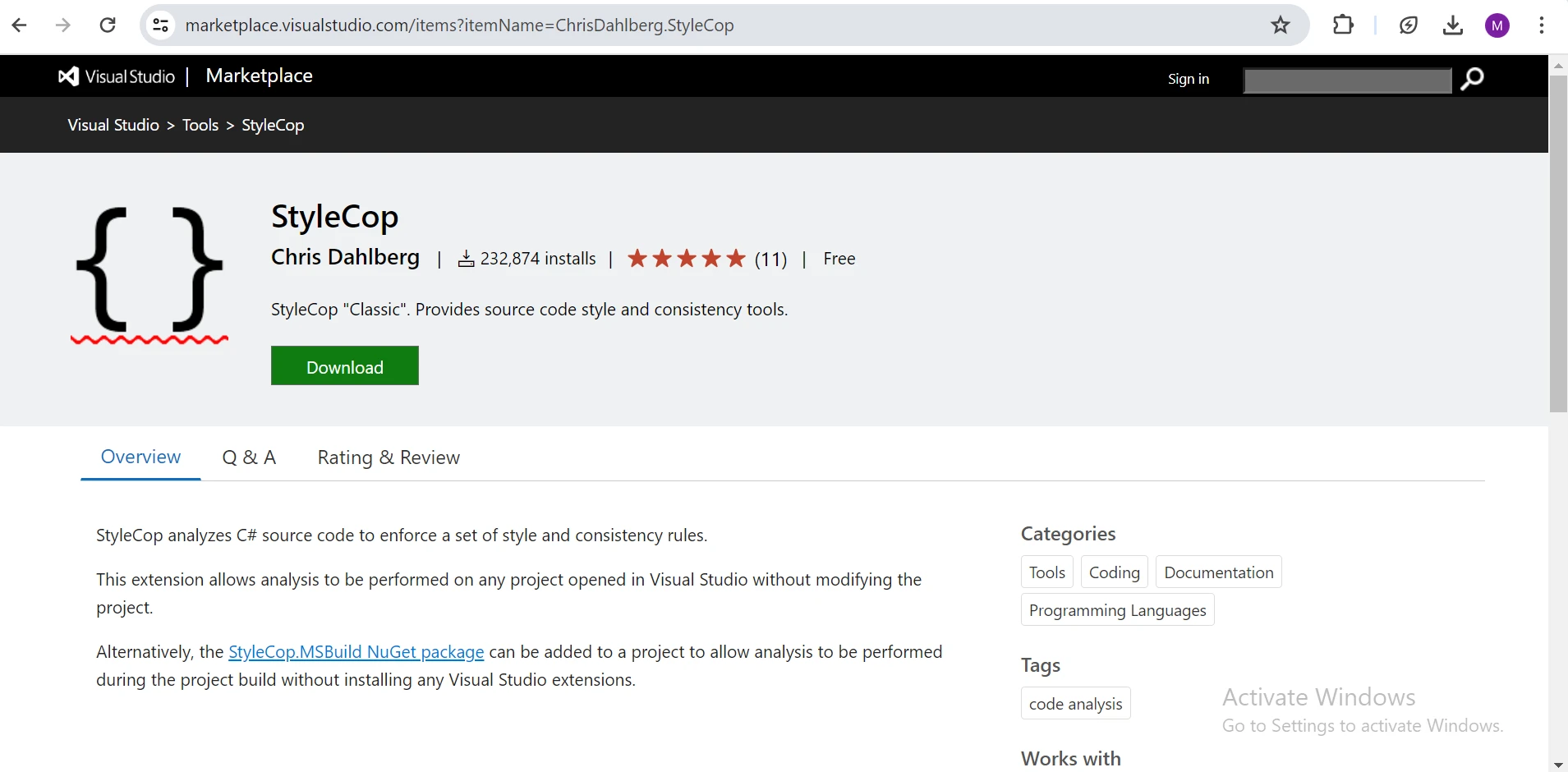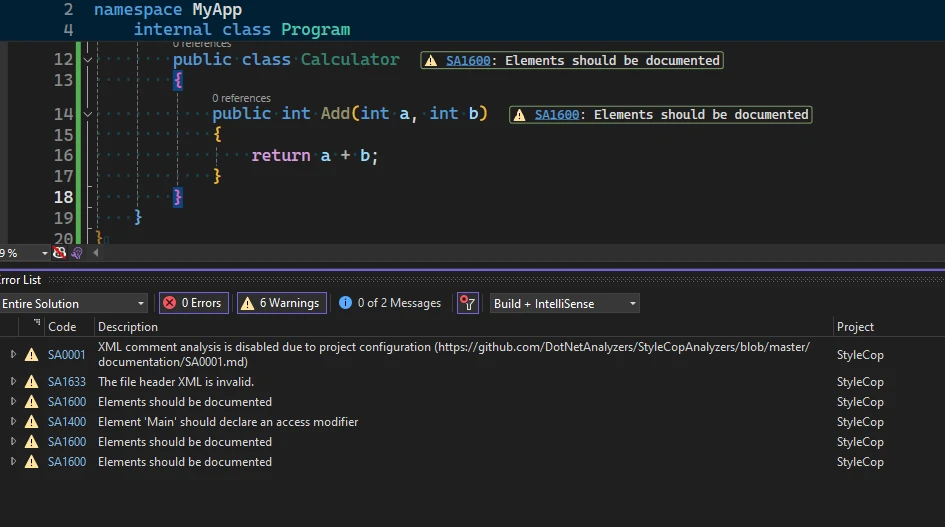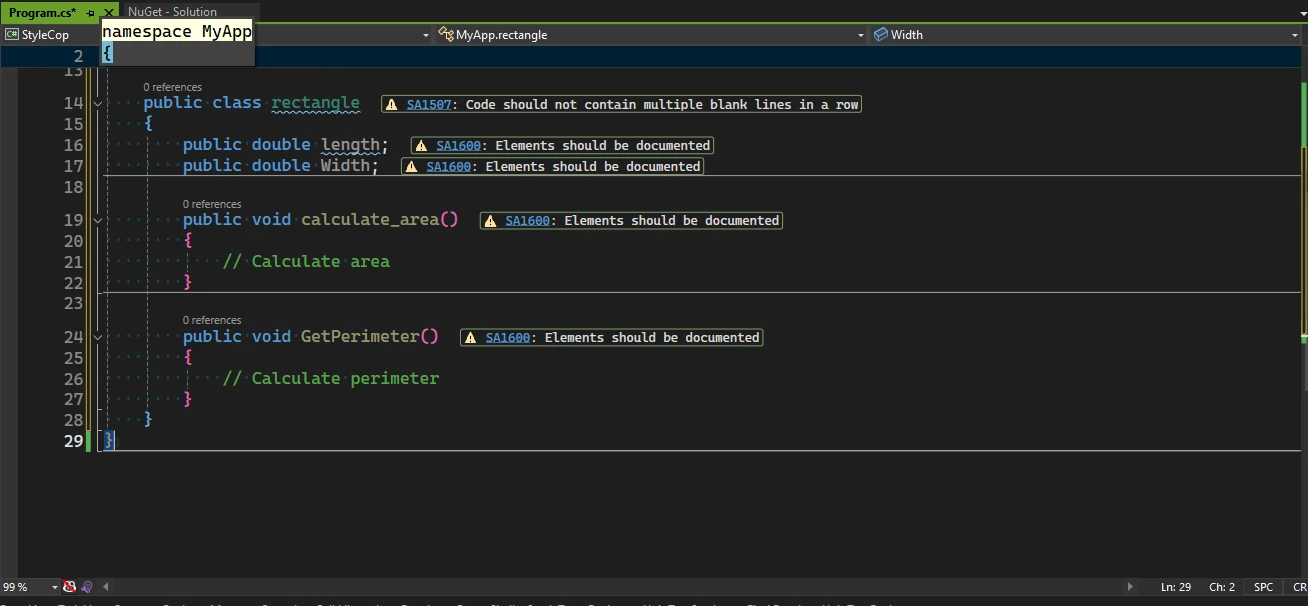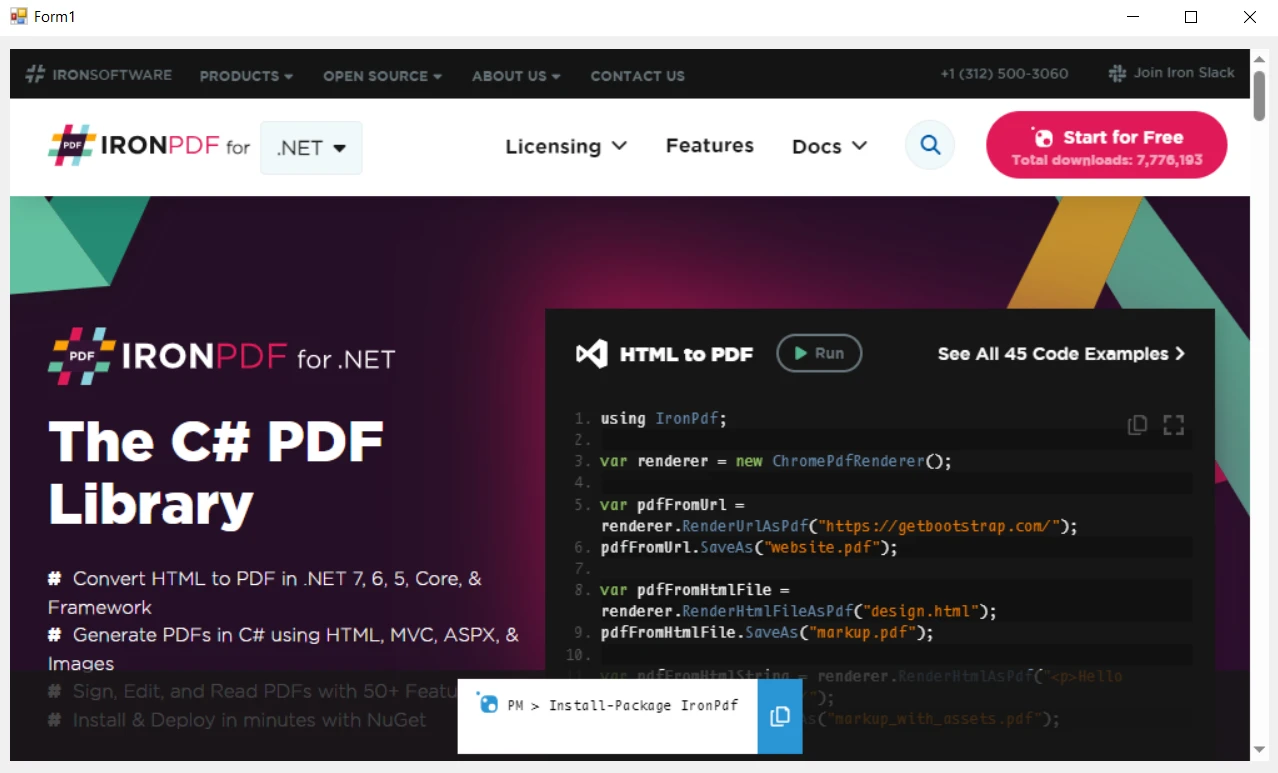Test in production without watermarks.
Works wherever you need it to.
Get 30 days of fully functional product.
Have it up and running in minutes.
Full access to our support engineering team during your product trial
When two developers collaborate, they will inevitably discuss coding style. Each developer has a unique way of writing source code, making consistency more important than choosing the perfect style. Tools like StyleCop help enforce coding consistency rules using a ruleset file, ensuring uniformity across the team or project. Consistency improves readability and makes debugging and maintenance easier, creating a more efficient development environment.
StyleCop is an open-source static analysis tool for C# that checks code for adherence to a predefined set of style and consistency rules or format rules. It integrates seamlessly with Visual Studio and can be incorporated into build processes to ensure code consistency across development teams. To configure StyleCop, you can use an XML file or JSON file to define individual rules that your project should adhere to. This XML file header allows you to customize the analysis by modifying the specific rules according to your project's needs. StyleCop supports a wide range of configurations, making it a flexible tool for maintaining code quality and consistency.

Begin by opening your project in Visual Studio. Next, go to the Solution Explorer, right-click on your project, and choose "Manage NuGet Packages". In the NuGet Package Manager, search for "StyleCop.Analyzers" and install it.

Alternatively, to install StyleCop Analyzers using the NuGet Package Manager Console, use the following command:
Install-Package StyleCop.AnalyzersInstall-Package StyleCop.AnalyzersIRON VB CONVERTER ERROR developers@ironsoftware.comThe above command will install StyleCop with all its dependencies. StyleCop can now be used with namespace declaration.

One common rule enforced by StyleCop is the requirement for documentation comments on publicly accessible methods and classes. This ensures that your code is well-documented and understandable.
// Source code without StyleCop
public class Calculator
{
public int Add(int a, int b)
{
return a + b;
}
}// Source code without StyleCop
public class Calculator
{
public int Add(int a, int b)
{
return a + b;
}
}IRON VB CONVERTER ERROR developers@ironsoftware.comWithout using StyleCop, the code lacks documentation comments, making it difficult for other developers to understand the purpose of the method Add and the parameters a and b. This can lead to confusion and decreased maintainability of the codebase.

If the coding conventions are violated, StyleCop issues warnings, as seen in the above screenshot within Visual Studio.
// Code with StyleCop
/// <summary>
/// Provides methods for basic arithmetic operations.
/// </summary>
public class Calculator
{
/// <summary>
/// Adds two integers.
/// </summary>
/// <param name="a">The first integer.</param>
/// <param name="b">The second integer.</param>
/// <returns>The sum of the two integers.</returns>
public int Add(int a, int b)
{
return a + b;
}
}// Code with StyleCop
/// <summary>
/// Provides methods for basic arithmetic operations.
/// </summary>
public class Calculator
{
/// <summary>
/// Adds two integers.
/// </summary>
/// <param name="a">The first integer.</param>
/// <param name="b">The second integer.</param>
/// <returns>The sum of the two integers.</returns>
public int Add(int a, int b)
{
return a + b;
}
}IRON VB CONVERTER ERROR developers@ironsoftware.comWith StyleCop, documentation comments are added to the code, providing clear information about the functionality of the Calculator class and its Add method. Developers can easily understand what the method does, what parameters it accepts, and what it returns, improving code readability and maintainability.
public class rectangle
{
public double length;
public double Width;
public void calculate_area()
{
// Calculate area
}
public void GetPerimeter()
{
// Calculate perimeter
}
}public class rectangle
{
public double length;
public double Width;
public void calculate_area()
{
// Calculate area
}
public void GetPerimeter()
{
// Calculate perimeter
}
}IRON VB CONVERTER ERROR developers@ironsoftware.comIn this source code, the class name (rectangle) and the property names (length, Width) violate style and consistency rules. Additionally, the method names (calculate_area, GetPerimeter) have an inconsistent casing, so Visual Studio will show a warning.

Explore the Capabilities of IronPDF is a leading C# PDF library that empowers developers to effortlessly create, edit PDF Documents with IronPDF, and manipulate Existing PDFs within their .NET projects. Whether you need to convert HTML to PDF, generate dynamic PDF files, or extract text and images from PDFs, IronPDF provides a user-friendly API that simplifies the process. It uses a .NET Chromium engine to render HTML pages into PDF files, making it an essential tool for software engineers working with C#. IronPDF’s compatibility spans across .NET Core (8, 7, 6, 5, and 3.1+), .NET Standard (2.0+), and .NET Framework (4.6.2+), and it supports various project types including web (Blazor and WebForms), desktop (WPF and MAUI), and console applications. When you need your PDFs to look like HTML, IronPDF delivers accuracy, ease of use, and speed.

using IronPdf;
namespace YourNamespace
{
public class PdfGenerator
{
public void generatePDF(string output)
{
// This code snippet does not adhere to StyleCop rules
var renderer = new ChromePdfRenderer();
PdfDocument pdf = renderer.RenderUrlAsPdf("<h1>Hello, World!</h1>");
pdf.SaveAs(output);
}
}
}using IronPdf;
namespace YourNamespace
{
public class PdfGenerator
{
public void generatePDF(string output)
{
// This code snippet does not adhere to StyleCop rules
var renderer = new ChromePdfRenderer();
PdfDocument pdf = renderer.RenderUrlAsPdf("<h1>Hello, World!</h1>");
pdf.SaveAs(output);
}
}
}IRON VB CONVERTER ERROR developers@ironsoftware.comBefore enforcing StyleCop rules, the code exhibits several violations: the method name generatePDF does not adhere to PascalCase convention, and the parameter output lacks clarity in naming. Additionally, implicit typing with var for the variable PDF reduces readability, and omitting the namespace for HtmlToPdf instantiation can lead to confusion, especially in larger projects.
using IronPdf;
namespace YourNamespace
{
public class PdfGenerator
{
/// <summary>
/// Generates a PDF from a URL and saves it to the specified file path.
/// </summary>
/// <param name="outputFilePath">The file path where the PDF will be saved.</param>
public void GeneratePdf(string outputFilePath)
{
// This code snippet adheres to StyleCop rules
var chromePdfRenderer = new ChromePdfRenderer();
PdfDocument pdfDocument =
chromePdfRenderer.RenderUrlAsPdf("<h1>Hello, World!</h1>");
pdfDocument.SaveAs(outputFilePath);
}
}
}using IronPdf;
namespace YourNamespace
{
public class PdfGenerator
{
/// <summary>
/// Generates a PDF from a URL and saves it to the specified file path.
/// </summary>
/// <param name="outputFilePath">The file path where the PDF will be saved.</param>
public void GeneratePdf(string outputFilePath)
{
// This code snippet adheres to StyleCop rules
var chromePdfRenderer = new ChromePdfRenderer();
PdfDocument pdfDocument =
chromePdfRenderer.RenderUrlAsPdf("<h1>Hello, World!</h1>");
pdfDocument.SaveAs(outputFilePath);
}
}
}IRON VB CONVERTER ERROR developers@ironsoftware.comIn the provided source code, StyleCop flags warnings for multiple violations of naming conventions. Specifically, the class name "rectangle" should adhere to PascalCase ("Rectangle"). Additionally, the field names "length" and "Width" lack consistency, as they should follow either camelCase or PascalCase conventions. Similarly, method names like "calculate_area" and "GetPerimeter" should be in PascalCase ("CalculateArea" and "GetPerimeter"). These warnings serve to enforce certain rules defined by StyleCop's rule set files.
Integrating StyleCop into your .NET projects ensures consistent coding standards, streamlining the development process with a customizable new rule set file and classic settings. StyleCop can be run via the command line to enforce these standards directly on the source code, enhancing readability and maintainability. Additionally, using libraries like IronPDF provides robust PDF generation capabilities, ideal for creating dynamic documents. IronPDF offers a free trial license for developers for those satisfied with its functionality.